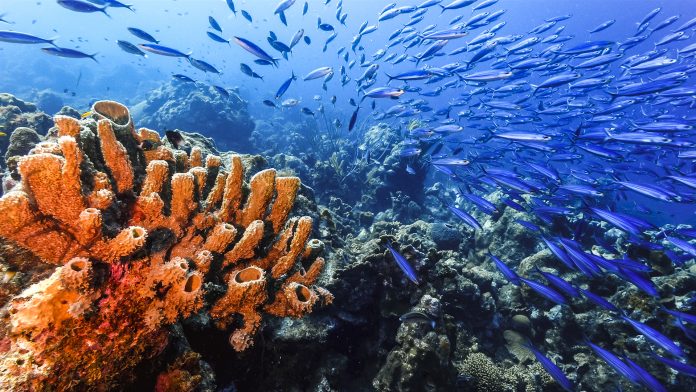Kazuhiko Koike, a professor of Hiroshima University, has found that the coexistence of giant clams with corals may be important for coral reef ecosystems.
Giant clams (tridacna shellfishes) are large bivalves inhabiting tropical coral reefs. They are important fishery resources, as they are used as food, as aquarium pets and for ornamental purposes. Currently, 13 extant species are recognised, and three species are categorised within the Vulnerable A2cd category on IUCN Red List of Threatened Species. Similarly, as corals, giant clams live on mutualistic symbiosis with zooxanthellae which provide photosynthetic product to the host animals. Zooxanthellae are essential for these animals to survive in oligotrophic environments of coral reefs. Interestingly, most of coral species and all giant clams must acquire these symbiotic partners from surrounding environment, not inherited maternally. Therefore, there must be host-free zooxanthella population in coral reefs, however it is impossible for zooxanthellae to survive for several days apart from host animals, and corals discharge only degraded zooxanthellae which are not infectious to other animals.
Kazuhiko Koike, a professor of Hiroshima University, Japan, has been long working on possible zooxanthella sources in coral reef ecosystem, and found faecal pellets of giant clams contained numerous live zooxanthellae. When these faecal pellets were provided to juveniles of giant clams, the juveniles actively took up the pellets and establish symbiosis with those zooxanthellae. The infection rate even surpassed the juveniles given with zooxanthella culture strains. This finding was previously reported in a journal (PLoS ONE), and more than 1500 views for five months has been recorded after the publication.
Dr Koike is also now working on another infection experiment, providing faecal pellets of giant clams to corals’ juveniles. The result has not yet published, but he concludes the coral juveniles also acquired zooxanthellae via the faecal pellets. If indeed the faecal pellet of giant clams is one of the plausible mechanisms in coral reefs that transport zooxanthellae to the animals those require external zooxanthella source, coexistence of giant clams with corals may be important for coral reef ecosystem. There are several genera or types in zooxanthellae that possess different physiology especially for temperature tolerance, and giant clams usually harbour many of them. Because the expelled zooxanthellae from giant clams are probably overflowed population that grew well under an exposed environment, for example under high temperature, faecal pellets could provide zooxanthellae growable in such condition to corals. If so, this function may increase the resilience of corals and other zooxanthella-bearing animals to survive under elevated temperature, which often causes a worldwide catastrophe of coral reefs (also known as ‘coral breeching’).
This study tells us about the importance of harmonious coexistence of various creatures in coral reefs, those that rely on each other and eventually form the beautiful nature. At the same time, the study suggests a risk of current thought about coral reef conservation which is mainly focusing on coral itself.
Kazuhiko Koike
Professor
Graduate School of Integrated Sciences for Life
Hiroshima University
+81 82 424 7996
kazkoike@hiroshima-u.ac.jp
https://home.hiroshima-u.ac.jp/gsbstop/interview/en/koike.html







